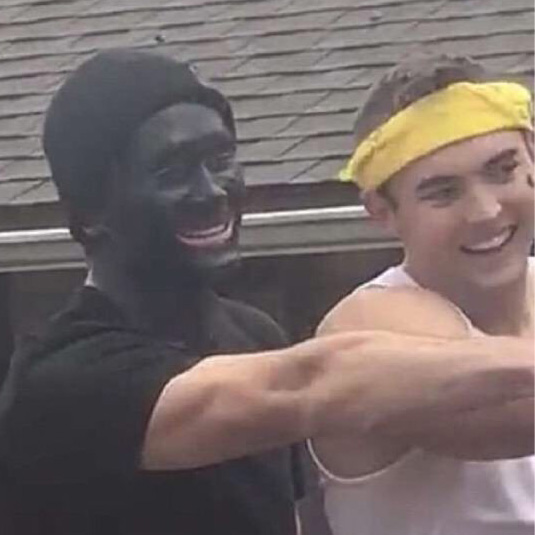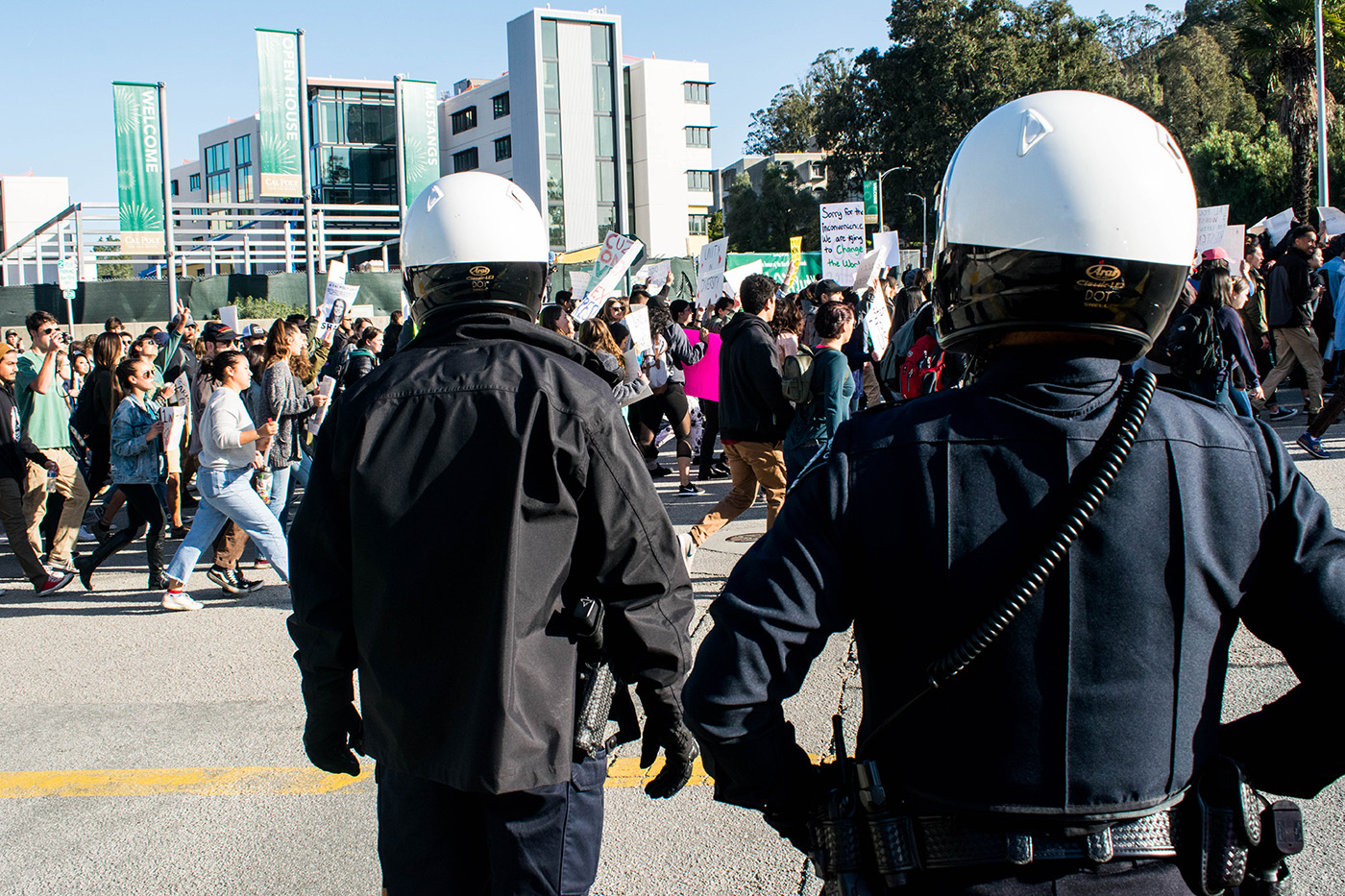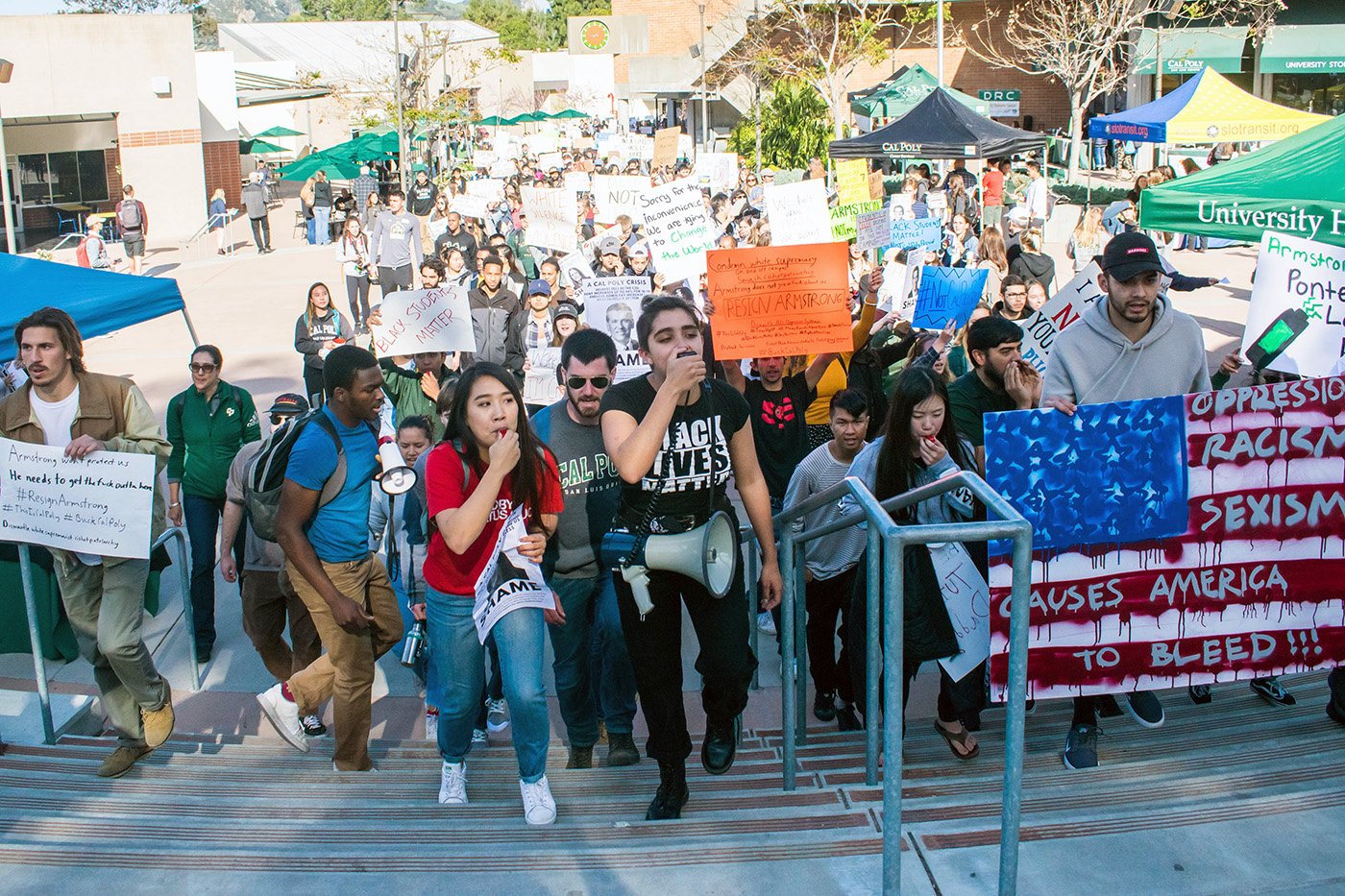“Disappointed, but not surprised.”
When sociology and psychology senior Olivia Gore’s phone lit up with messages regarding a photo of Lambda Chi Alpha fraternity member Kyler Watkins donning blackface next to another fraternity member in a bandana and a drawn-on teardrop last April, she said she felt jaded; that it was not the most outlandish thing to happen at Cal Poly.
The current president of the Black Student Union and then-treasurer said she felt disconnected from the rest of campus.
“We [as people of color] turn into ourselves and think about how are we going to heal ourselves and fix ourselves and help ourselves, because when [something racist] happen[s], we don’t really see ourselves as part of the Cal Poly community,” Gore said. “We see ourselves as outside of it.”
 Beya Montero-Makekau remembers when she saw the photos. Montero-Makekau, the lead coordinator for multicultural initiatives at the Cross Cultural Centers, was coming up on the end of PolyCultural Weekend (PCW), an annual student-run weekend of events designed to welcome conditionally admitted high school seniors and transfer students, when her phone dinged. So did the phones of all of her colleagues. One after another. She soon “kicked into a gear [she] didn’t know [she] had.” She worried the prospective students would think her and the other PCW student organizers were frauds or that they had lied to them.
Beya Montero-Makekau remembers when she saw the photos. Montero-Makekau, the lead coordinator for multicultural initiatives at the Cross Cultural Centers, was coming up on the end of PolyCultural Weekend (PCW), an annual student-run weekend of events designed to welcome conditionally admitted high school seniors and transfer students, when her phone dinged. So did the phones of all of her colleagues. One after another. She soon “kicked into a gear [she] didn’t know [she] had.” She worried the prospective students would think her and the other PCW student organizers were frauds or that they had lied to them.
“We were working really hard to make a more diverse and inclusive campus for students at Cal Poly and committing to [prospective students] that this place and this campus is for them and that there is a community for them here and that they do belong here and that’s what we were doing when we received the information about blackface,” Montero-Makekau said.
The president of the fraternity initially described the event as a color-themed party. Just hours later, another photo of 13 members of the fraternity circulated from the same event, dressed in what electrical engineering senior Alejandro Bupara described as “looking a whole lot like what [he] wear[s] everyday, down to the throwback Air Force 1s.”
The caption on the photo posted to Instagram by a fraternity member read, “She want a gangster not a pretty boy.”
Ultimately, Bupara said the photos felt “like business as usual.” Bupara is an organizer for Cal Poly’s chapter of Students for Quality Education (SQE), a direct action social justice organization on almost all California State University (CSU) campuses.
“It was absolutely infuriating and things like this are constant on this campus,” Bupara said. “Just about every year we deal with something like this, and we don’t even have time or space to process it a lot of the times.”
Assistant Vice President for Student Affairs, Diversity and Inclusion Jamie Patton attended a greek life retreat just weeks earlier where he asked the students if they believed an event like this could happen on Cal Poly’s campus. The overwhelming response was no. He said the blackface was the first time he could remember having a physical reaction to an event that occurred on campus.
“I left that [retreat] feeling really good and after that happened, I understand it was one individual, but it was larger than that, because while it was just one, or those who chose to do those things, there were others there who were not active bystanders, who had to know, and not one was like, ‘Really? We’re really gonna do this?’” Patton said.
 Whatever their first impressions — be it disgust, grief, apathy — none of them fully grasped the effect the events of last spring would have on their lives, the university, or campus climate as a whole. The photos quickly garnered international headlines.
Whatever their first impressions — be it disgust, grief, apathy — none of them fully grasped the effect the events of last spring would have on their lives, the university, or campus climate as a whole. The photos quickly garnered international headlines.
Racism on campus
As a member of the BSU, SQE, the Queer Student Union, as well as a handful of other on-campus organizations at the time, comparative ethnic studies junior Leilani Hemmings-Pallay felt the responsibility to organize an emergency town hall the following evening. The event harbored more than 300 attendees from all parts of campus. She said she felt it was the easiest way to have the conversation that needed to be had.
Hemmings-Pallay was a prominent organizer of protests that ensued in the following weeks and was outed as an organizer of The Drylongso Collective, an anonymous social justice student group on campus. She said she received numerous threatening emails, some of which were so aggressive she had to pass them on to the university and San Luis Obispo police departments. For the first time in her life, someone also yelled the N-word in her face following a protest.
“I’m not physically very domineering or anything like that and … [with] the lack of a population that looks like me or has the identities that I have, I’ve never really felt safe on campus,” Hemmings-Pallay said. “In general, there are people that walk around in Trump hats or who walk around voicing their support of things that are actively harmful to people in general, but particularly marginalized people.”

Though she said she had never felt safe on campus before the events of Spring 2018, things had intensified. Her friends asked her to share her location with them in case anything happened to her, professors did not want her walking home alone after class, friends invited her to stay over frequently, people even checked her apartment if they had not heard from her.
After a member of the BSU was spat on following a protest, Gore said she felt unsafe by extension. She felt vulnerable in a way she never had and said she felt she had to be extra vigilant. She was interning at the County Probation Department at the time and her supervisor offered to drive her to class. She sat in the back of her classroom and gave her a ride home afterwards.
“That was the only thing that made me feel safe,” Gore said. “I loved that she did that for me, but it is so absurd that I would need that to happen in order to feel safe on campus.”
The issue of racism is in no way unique to Cal Poly. However, there are a number of factors that lend themselves to Cal Poly being so ripe for situations of discrimination. For one, Cal Poly is the whitest and wealthiest public university in California.
In 2018, The USC Race and Equity Center ranked Cal Poly as one of the worst universities for Black students. In 2017, the Education Trust ranked Cal Poly in the seven worst institutions for Latinx success.
According to the Institutional Research PolyView, as of Fall 2018, 54.6 percent of Cal Poly students were white, with a total of 11,888; 17.03 percent were Hispanic/Latino students with a total of 3,708; 13.08 percent were Asian American students with a total of 2,848; 0.78 percent were Black students with 169; and 0.14 percent were Native American students with a grand total of 31. The surrounding city of San Luis Obispo is also significantly whiter than California as a whole, according to U.S. census estimates.
Bupara said he regularly experiences microaggressions — indirect, subtle, or unintentional acts of discrimination against persons with marginalized identities — on campus. He said women often clutch their purses when he walks by, his intelligence is frequently questioned, professors are less lenient with him than with white students, and he regularly hears white students make jokes about Black and brown people in class. Bupara said the microaggressions build up and put a toll on marginalized persons on campus.
“Even if you might not feel the impact in the moment, when you go home and sit down and think about the day, you’ll be like, ‘Oh yeah, that was terrible,’” Bupara said. “A lot of us don’t even like to be on campus for longer than we have to.”
 Though these issues persist at Cal Poly, Montero-Makekau said the issue is much larger and lies in the foundation of the institution.
Though these issues persist at Cal Poly, Montero-Makekau said the issue is much larger and lies in the foundation of the institution.
“I think we know universities were historically founded for a specific person, and that specific person is the white cis[gender] male, that’s our history, that’s our reality, institutions are historically racist,” Montero-Makekau said. “So we have to be able to acknowledge and recognize that and I think that that systemic racism has been upheld for a long time.”
Hemmings-Pallay said that not only are institutions racist, but that the university is a microcosm of the outside world; she said there are many larger systems at play at Cal Poly.
“A lot of this isn’t happening in a vacuum,” Hemmings-Pallay said. “Things like spring quarter have happened before, they will continue to happen at Cal Poly and in the larger United States as we’re seeing with all these politicians that are having flirtations with blackface and all that stuff … none of it’s new or going to stop just because of how spring quarter went.”
The university’s response
Immediately following the emergence of the photos, President Jeffrey Armstrong sent a campus-wide email addressing the issues. The following day, the university as well as the national Lambda Chi Alpha headquarters suspended the on-campus fraternity. Three days later, Armstrong, the Office of University Diversity and Inclusion (OUDI) and Student Affairs held a student forum in Harmon Hall. When asked why Watkins was not being expelled, Armstrong said the Supreme Court protects free speech and that “that’s the world that public universities live under.”
Nine days after the photos surfaced, Armstrong announced a temporary interim suspension of all Panhellenic and Interfraternity Council (IFC) sororities and fraternities. At the end of April, administration announced a partnership with Diversity and Inclusion Specialist Kimberly McLaughlin-Smith.

In early May, Armstrong announced that the university had turned an investigation of the blackface as well as a handful of other reported incidents of racially insensitive behavior over to the California Attorney General to determine whether or not the students had violated any of the university’s policies.
On June 7, 2018, the OUDI shared a 30-page “Diversity Action Initiatives” document with the community, outlining 137 ongoing, 21 completed and 34 future Cal Poly diversity initiatives, going back as far as 2011. The initiatives included a Student Diversity Advisory Committee which has since been implemented, a general education redesign, as well as introducing a 10-week diversity seminar for students.
In Sept. 2018, Armstrong announced the implementation of the Cal Poly Opportunity Fee, designed to provide financial assistance for low-income and first-generation California students through a fee paid by out-of-state students starting Fall 2019. Around the same time, Armstrong lifted the blanket suspension on greek life. New students also attended newly mandatory diversity training sessions during Week of Welcome. In October, IFC voted to lift Lambda Chi’s suspension, though they were still suspended from their national headquarters until April 2019. Shortly after, Armstrong announced that the California Attorney General found the blackface was protected by freedom of speech.
While the university has spearheaded a number of different diversity initiatives in recent years, the most recent effort is the Cal Poly Experience (CPX), which kicked off with a series of listening sessions and will be followed by a campus-wide survey, ultimately leading to the development of an action plan. CPX was organized with the help of Diversity Specialist Damon Williams and his Center for Strategic Diversity Leadership and Social Innovation team, a partnership that cost the university approximately $243,000.

The future of campus climate
Bupara said he thought it was silly the university spent so much money to get recommendations for the changes student groups, such as SQE and The Drylongso Collective, have been asking for for years.
SQE and The Drylongso Collective have individually published demands for the university, both of which include prioritizing student safety, allocating funding for marginalized student groups, and holding all organizations accountable for the actions of their members. They also both included requiring Women’s and Gender Studies courses as well as Ethnic Studies courses.
“The undercurrent of racism is constant here and administration has not done anything to meaningfully address that, they’re not addressing it at all,” Bupara said. “As always, they’re putting it on students to address that. We are not leaving it to them, we are fighting for us, we have told them what we want to see and we will continue to tell them what we want to see.”
Montero-Makekau said offering more scholarships and focusing on shifting campus culture and the university’s core values as well as zero tolerance policies would be steps in the right direction. Gore said requiring courses in Ethnic Studies, Women’s and Gender Studies, and/or Sociology would help change the attitudes of students.
“I know as a polytechnic university, there’s a huge focus on STEM, but that might be a detriment to the students if they aren’t learning that blackface is wrong,” Gore said.
Hemmings-Pallay said she felt many of the people on campus with misogynistic, homophobic, racist views, are never reprimanded for having these views or even challenged in any way. She said the university does not actively discourage bigotry in any way.
 Vice President and Chief Officer for Diversity and Inclusion Jozi De Leon said sometimes students have a different view of what administration is doing and is able to do.
Vice President and Chief Officer for Diversity and Inclusion Jozi De Leon said sometimes students have a different view of what administration is doing and is able to do.
“Sometimes our students don’t see it the way we do because they’re not in it every day … so much energy is being put into ensuring we’re on a transformational path,” De Leon said. “[There are] so many people leading this effort and that doesn’t happen at every university. That’s why I came here, not only to be a part of that transformation, but to serve as a model for others”
Though Watkins’ blackface is one of many blatant incidents of racism on campus, campus leaders and student activists alike said they were optimistic about the future of campus climate.
“Sometimes when something so awful happens, it also provides a time for growth. That’s hard to see at first, but when I look at the great work so many are doing to cultivate diversity, equity, and inclusion across the campus, and at the tireless efforts of so many who have been in the trenches of this work for so many years, I have hope,” College of Liberal Arts Associate Dean for Diversity and Curriculum Jennifer Teramoto-Pedrotti wrote in an email to Mustang News.
Patton said he saw the blackface as an opportunity to accelerate the change that was needed. Montero-Makekau said she is in this line of work because she knows the university can do better and needs to do better. However, she brought attention to the amount of recognition Watkins’ blackface received.
“I think it is an anniversary of blackface, but every year is an anniversary of some racist incident for some student … I think we have to ask ourselves why we pay so much attention to this specific incident, why are we having these articles come out? Is it because it was a blackface incident? Is it because it made it in national news? Is it all of the activism surrounding it?” Montero-Makekau said. “You can go into our history … and know that this is not an extreme circumstance, and I think that’s something our students kind of live with in the back of their heads, is why are we paying so much attention to this one incident when students have been experiencing these incidents from maybe the moment they stepped foot on campus, and are there news articles about that? It’s the anniversary of an awful incident, but every year is an anniversary of some awful incident.”

